
Watershed
Restoration Stewardship
Landowner Interviews
In winter term of 2005, the team had the opportunity to interview some of the private landowners about their projects. Below, are some of the stories of these landowners, project histories, and valuable advice for people thinking of beginning their own projects in the future.
The Bontrager Story
Dave Bontrager owns a piece of land near Dexter, Oregon through which a small, unnamed tributary of Lost Creek in the upper Lost Creek Watershed flows. Planting began on this site about 10 years ago. This site has approximately 10 acres that could be restored, but at this point, only 4-5 acres have been planted. Bontrager estimates that 1200 stock have been planted thus far, and a small percent are trees. Most are shrubs.
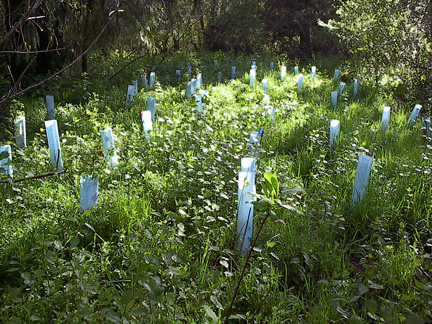
Planting site at Bontrager
Being a biologist and bird enthusiast, Bontrager provided his own technical assistance. He received funding from OWEB (Oregon Watershed Enhancement Board), and the grant included provisions for 40-50 hours per year of work. However, he estimates that he has logged far more hours. In an acceptance speech for the 2004 Fish and Wildlife Steward Award for Non-industrial Forest Lands in Northwest Oregon, Bontrager thanked a couple of groups. ODFW (Oregon Department of Fish and Wildlife) and their scientists--biologists and hydrologist--were instrumental in his project planning. Amy Chinitz, coordinator for the Middle Fork Willamette Watershed Council, was a great support, providing assistance with grant proposals and volunteer recruitment. In addition, AmeriCorps volunteers helped with some of the labor.
At the project's conception, Bontrager had two types of goals: in-stream and terrestrial. The stream was incised and disconnected from the surrounding terrain. It no longer had a relationship with the floodplain. In an attempt to reestablish this connection, Bontrager installed log structures in the streambed. This benefited the stream in many ways. The logs diverted some water to form additional channels, raised water levels, and increased spawning habitat for trout and other salmonids. The log structures increased stream complexity by trapping sediment and allowing the water to leave the stream channel during peak flow events. This provides the landscape with much needed nutrients and further alleviates the need for irrigation. Although he hasn't seen it happen recently (due to lack of precipitation), it worked perfectly during the last high flow event.
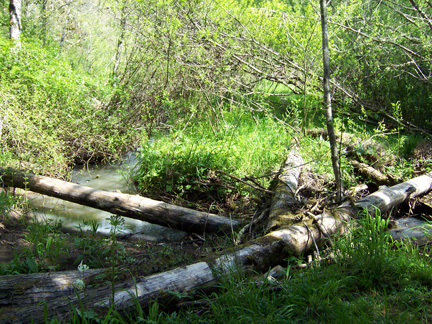
Log Jam Structure at Bontrager
For his terrestrial goals, Bontrager wanted to rid the area of homogeneous, non-native plant cover and replace it with native successional growth. As a bird enthusiast, he was interested in reestablishing bird habitat and biological integrity. In addition, planting near the stream will improve water quality by adding organic material (leaves and insects) to the water and providing shade for aquatic habitat.
As in all well thought projects, Bontrager's goals and motivation were connected. When he bought this beautiful piece of land and discovered it was overgrown with retched, non-native plant cover, as a biologist, he felt compelled to repair the damage and restore bird and other natural habitat. Bontrger worked for US Fish and Wildlife as a restoration expert for many years in southern California, and it felt instinctive to continue the work up here in Oregon.
Blackberry bushes have proved to be a sizable challenge, as they have a way of dominating a landscape and choking out all other life. In an attempt to control their growth, Bontrager cut the blackberries back with a metal-bladed weed trimmer to a 6-inch stub (in order to locate the base later). In areas where native species were present, Bontrager embarked on the lengthy process of following the chains of blackberries back to the base by hand. After the blackberry chains were cut back, there are a couple of options. He could either lay matting to suffocate the blackberry or go in with a tool (shovel, etc) and dig up the roots as much as possible. After planting, it is important to stay atop the blackberries. If the terrain is level and the planted stock sufficiently spaced, he mows the site. Otherwise, it is necessary to clear the blackberry and other invasive species by hand or with a metal-bladed weed trimmer. They are resilient, but Bontrager doesn't use herbicides and emphasizes the importance of mulching, especially in times of drought.
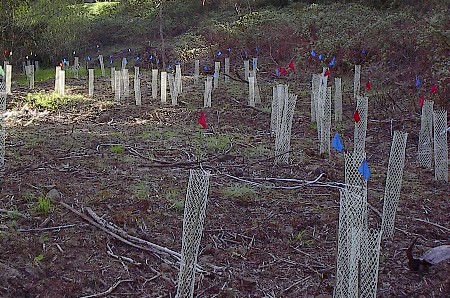
Plot with Blackberries behind it.
Bontrager had some advice for future restoration-minded landowner that he wanted to share. The most important being, "don't undertake this process, unless you mean it." A single project, regardless of size, can take relentless maintenance for 3-5 years. He also emphasized the importance of working with an expert and not taking on a larger project than you can manage. The second most important piece of advice was, "don't turn your back on the blackberries." Clearing blackberry takes hours of hard, physical labor, and it is disappointing to see that all wasted.
In the future, Bontrager would like to try his hand at oak savanna and wetland restoration, and he may have his chance. He hopes to restore the remaining 5-6 acres but will follow a different plan. That portion of his property is wetland (not riparian), the planting will be more scattered. Although he feels like he bit off more than he could chew, Bontrager is always happy to help things grow. It is very satisfying as a biologist and "someone who is emotionally connected to the aesthetic part of restoration" to see birds make nest in the trees planted during these projects.
The Huhtanen-Schöller Story
Karen Schöller and Richard Huhtanen own 82 acres within the Long Tom Watershed. A half of a mile of the old, windy river runs through their property, where the secondary channel system remains intact. When Schöller and Huhtanen first bought their property, almost three years ago, they had two specific goals in mind: to have a place where Karen could train and ride her horses and to continue their efforts as thoughtful stewards to the land. When making these decisions, they asked, "How do we protect the river?" Despite previous owners farming and cattle grazing, the area along the river experienced very little impact. Red-legged frogs, wood ducks, various woodpeckers, and western pond turtles are found along the property.
With a year and a half of planning, Schöller and Huhtanen set aside 35-40 acres for restoration efforts and habitat renewal. The first task involved the removal of a ten-foot wall of Himalayan blackberry that took over valuable habitat and blocked access to the river and various ponds. PacWest Excavating's Bobcat Jeff, brought a bobcat with a large mowing blade to tear up most of the blackberries. Richard followed the mowing with spot herbicide treatments. After the blackberry had been cleared, in January of 2005, 1200 trees were planted. Among the trees and shrubs planted are Oregon ash, big leaf maple, twinberry, cascara, snowberry, red alder, Indian plum, Douglas spiraea, nootka rose, white oak, Pacific ninebark, Oregon grape and ponderosa pine. The goal of the planting is to shade out blackberry habitat and create more space for the various critters that live in the area.
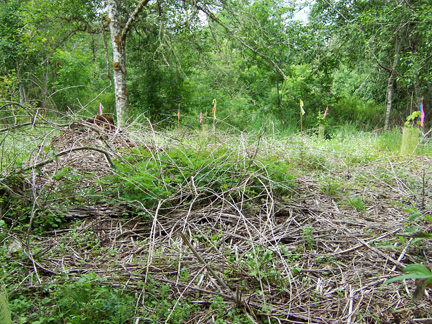
Encroaching/Dead Blackberry Bushes
The majority of the funding came from the Long Tom Watershed Project and 2-5 acres qualified for support from the Conservation Reserve Program (CRP) Project. Cindy Thieman, projects and monitoring coordinator for the Long Tom Watershed Council, is the project manager and has provided an endless amount of support in helping Schöller and Huhtanen create a plan that nurtures their dreams and goals for the property. Thieman has not only helped design the project, but has also been a bridge to access various landowner management classes that saved time and money. Thieman has given contact information of various consultants and experts, and been available for moral support as well.
Richard will take on the maintenance of this large endeavor. With plenty of summer watering, Huhtanen will have his hands full. Luckily, he will have a water truck and road accessibility to most of the plantings. Besides tree and shrub maintenance, reed canary grass will also require constant looking after. The project is young and there are high hopes for its success.
For those interested in doing projects of their own, Karen Schöller is a wealth of valuable advice. First of all, she says, "take three long breaths." Constantly ask yourself what your goals are, what kind of time and energy will this take and more importantly, what is your fantasy about your project? Begin the process with the Watershed Councils. They are non-regulatory; they know everything and are connected to everyone. Watershed Councils will ask questions for you and help you educate yourself about your property and its potential. When someone comes to your property, an expert from Fish and Wildlife or a botanist for example, phrase your questions to them in a personal manner so that you get a personal response: "If this was yours , what would you do with it?" Keep having your fantasy, but remember to be flexible about your plans, your goals, and the issues-- because all of these will change. There may not be any right answers and everyone you talk to will have different solutions.
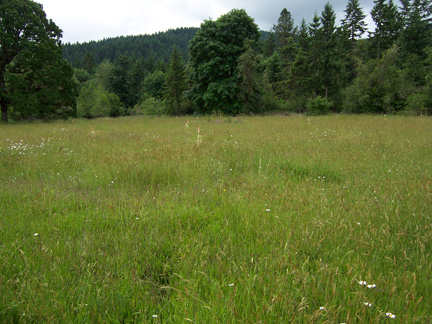
Open Meadow with Oak Plantings
When asking Schöller how she feels about her project, she says, "I am awestruck." Planting trees felt so good and she is relieved to have that phase of the project completed. The support from the Long Tom Watershed Council (LTWC) and CRP has exceeded her expectations with the quality of trees they provided and the support they have given. The LTWC alone provided time, advice, material, trees, flagging and stakes. The only expense Karen and Richard have had to carry has been the cost of herbicides for the blackberry and their valuable time. In one year, they have seen the duck population double!
In the future, Karen envisions taking half of their property out of a buyer/seller relationship and protecting it permanently under some sort of land trust. There is more space to be explored by biologists for woods, plants, and animals: areas that are still left relatively unexplored by Huhtanen and Schöller. For now, there is the first project to complete. After that, who knows? One thing remains certain; our knowledge of how to be good stewards is an evolving process, and one to which Karen Schöller and Richard Huhtanen have dedicated themselves.
The Taylor Story
As a fisheries biologist for the Army Corp of Engineers, Greg Taylor easily recognized the need for riparian vegetation along the back edge of his property, along Lost Creek a tributary to the Middle Fork Willamette. The area, virtually devoid of all riparian vegetation also had blackberry encroaching. Wanting to restore habitat for birds and fish, Greg soon enlisted the help of Dave Bontrager, a friend and Wildlife Biologist, who had designed several other restoration projects in the watershed. Bontrager came up with a plan to replant the site, which is approximately 150 feet by 30 feet, with a variety of native species including: Indian plum, snowberry, willow, ash, cottonwood, and dogwood. With Bontrager's assistance Greg was able to draw up a grant proposal, which he then submitted to the Oregon Watershed Enhancement Board (OWEB) for approval. OWEB provided Greg with the small grant he had been seeking and planting of the site was completed in 2004.
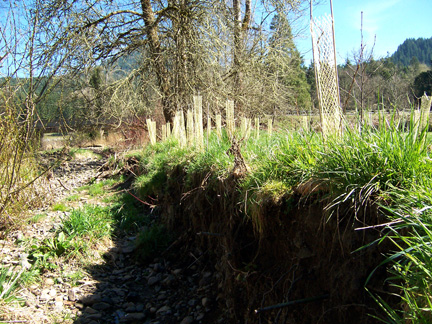
Eroding bank along Lost Creek
Preparation of the site was minimal. Blackberry was removed, the site was mowed, and black plastic sheeting was laid down to help control weed growth. Together, Greg and Bontrager planted all the purchased stock. Maintenance of the site has varied throughout the year. In the summer watering has been the top priority and Greg uses a sprinkler to help achieve the task. Greg also does occasional grubbing and mulching to help maintain the site. Greg stated that he has made the maintenance of the site work for him, putting in an average of a couple of hours a week during the summer, while during the winter months the site is maintenance free.
Now a year into the project Greg states that he is happy with the results, "The growth of the plants has made me pretty happy and we've had good survival." Greg also added that the project has proved not to be too burdensome and that the time and energy commitments have been consistent with those laid out by Bontrager during the projects inception. Greg confessed that he wishes the project could be five years from now, so could enjoy the full benefits of the project today. However, he recognizes that the restoration is moving along well and that time is needed to bring the results he is looking forward to: a restored riparian community that provides needed habitat for surrounding wildlife.
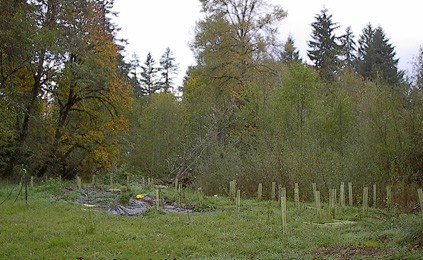
Overview of Taylor Site
During the project Greg received support in his efforts from Bontrager and the Middle Fork Willamette Watershed Council, both of whom he has worked closely with in the past and throughout the project.
When asked what he would tell a person just getting started on a restoration project Greg replied, "That it takes work, but to stick with it." Greg also advised that working with OWEB throughout a project could be a bit of a challenge, especially if the project undergoes any changes before or during the actual planting. In his experience OWEB has become more stringent on what is reported in the grant proposal matching exactly what is done on the site and was disappointed with his own back and forth experience with OWEB. However, he acknowledges that since OWEB is offering financial support for projects, meeting their demands may be well be worth the time and effort.
For future restoration projects on or around his property Greg indicated that he could imagine looking into a project to restore the upland vegetation near his home. Furthermore, he stated that he would like to see what could be done about a local county culvert that is preventing fish passage along Lost Creek, which remains the last un-damned tributary on the Middle Fork Willamette. In addition, Greg suggested that a study to discover the upper reaches of reed canary grass in the area could be useful for concentrating efforts toward its removal.